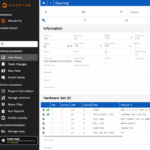![]() I recently read an article from CBS News – Toronto, about a Canadian man who is lobbying the Ontario government to amend the Building Code and Highway Traffic Act to incorporate a new accessibility symbol. This symbol is more dynamic than the existing symbol used on signage indicating accessible parking spaces, automatic door actuators, and other accessibility features. The driving force behind this change is the Accessible Icon Project, which began in Boston and has gone global, leading some US cities and states to mandate use of the new symbol.
I recently read an article from CBS News – Toronto, about a Canadian man who is lobbying the Ontario government to amend the Building Code and Highway Traffic Act to incorporate a new accessibility symbol. This symbol is more dynamic than the existing symbol used on signage indicating accessible parking spaces, automatic door actuators, and other accessibility features. The driving force behind this change is the Accessible Icon Project, which began in Boston and has gone global, leading some US cities and states to mandate use of the new symbol.
The dynamic symbol is already required for new installations in Connecticut and New York. The Connecticut law reads, in part:
“Not later than January 1,2017, the Commissioner of Administrative Services shall promulgate a policy and adopt regulations, in accordance with the provisions of chapter 54 of the general statutes, designating the symbol of access to be used on signage indicating access for persons with disabilities. Such symbol shall depict a logo with a dynamic character leaning forward with a sense of movement, be readily identifiable and be simply designed with no secondary meaning. Such symbol shall signify equivalent facilitation and accessibility as the previously used international symbol of access.”
The New York law went into effect in November of 2014, and this article from Seyfarth Shaw talks about the conflict created by New York’s requirement to use the dynamic symbol, vs. the ADA requirement to use the International Symbol of Accessibility (ISA). The US Access Board recently issued some guidance on this topic (you can read the complete bulletin here):
“While the ADA Standards do not recognize specific substitutes for the ISA, they do generally allow alternatives to prescribed requirements that provide substantially equivalent or greater accessibility and usability under a provision known as ‘equivalent facilitation.’ However, in the event of a legal challenge, the entity pursuing an alternative has the burden of proof in demonstrating equivalent facilitation. Under the ABA Standards, use of a symbol other than the ISA requires issuance of a modification or waiver by the appropriate standard-setting agency.”
For those of us who specify and supply products that include an accessibility symbol (like actuators for automatic operators), the new symbol may be required, depending on the laws and accessibility standards of the state where the project is located. However, not all agencies have approved the new design, and some jurisdictions may not accept the new symbol, so it remains to be seen whether this will become a nationwide standard.
Do you know of any jurisdictions that require the dynamic accessibility icon? Let us know!
You need to login or register to bookmark/favorite this content.





WHY?
IMO, this is a ‘no-brainer’. The dynamic icon is objectively superior to the conventional passive ISA icon, and certainly meets the ‘substantially equivalent’ criterion. I suppose there is value in asking for acceptance from the various local authorities on a case-by-case basis, but I’d rather see these authorities just be proactive and advise their blanket acceptance. Would welcome hearing arguments why the dynamic icon should not be acceptable, especially from the physically-challenged community.
Yesterday a pretty dynamic discussion ensued at my presentation when this symbol came up. There are several schools of thought. 1. It was said that this symbol has been contended as NOT being substantially equivalent ISA. 2. Some activists who are disabled but not wheelchair-bound do not like the symbol or the ISA symbols being all-inclusive of disabled people. 3. Some are confused by the symbol who are not familiar with it. Remember ADA is a federal not state law so the risk will be on the business owner if an issue arises over non-ISA symbols. The DOJ hasn’t issued formal guidance regarding the signs although the are popping up in projects outside of NY and Conn. El Paso TX has some projects with the newer symbol.
While I understand the thinking behind this change, it is (in my opinion) a distinction without a difference. Just as the “Male” and “Female” icons have static and dynamic versions (e.g. on a toilet versus at a crosswalk), then the dynamic ADA symbol could be adopted equally for different functions. An accessible area of refuge is a place of static rest, and an accessible egress route is a dynamic path. But by placing a dynamic ADA symbol on, say, a toilet without likewise having the other symbology “running to the loo” is farcical. To mandate that the ADA symbol be universally adopted as only the version will only serve to differentiate and highlight the disability of the users.
What about the feelings of wheelchair bound persons that are not “dynamic” and are in fact very limited in their mobility. Would this new symbol be offensive to them?
do existing actuators & sings need to be changed?
Not typically, unless the existing symbols were installed after the state law was changed to require the dynamic symbol.
– Lori
“…consider the importance of a highly standardized and internationally recognizable symbol.” We have that. This does nothing to make accessible parking or spaces more visible.
While extolling the superiority of this symbol, the author glosses over objections identified in the article. “The arm pushing a chair is symbolic—as all icons are symbols, not literal representations.” Yep; just as the existing symbol is symbolic.
If the powers-that-be agree to accept either symbol, and no one decrees that one should be replaced with the other, it won’t matter, but replacing existing symbols would be a waste of time and money.
Perhaps I’m not as refined as Mr. Rick House above. If I hurt someone’s feelings, too bad.
Wow. It’s a symbol. Does it matter whether it’s dynamic or passive? The typical men and women signs with symbols that are merely glorified stick-figures certainly aren’t dynamic. Is anyone complaining about that? The current symbol gets the point across and is widely recognized. It’s ridiculous how much this country caters to everyone so nobody gets their feelings hurt. We’re becoming a nation full of sissies. “PC” has gone too far.
Most people probably didn’t hear about Harvard University eliminating their library book late fee (50 cents per day) because “it’s too stressful to the students”. Too stressful to young adults that, allegedly, are some of the brightest individuals in the world. If a 50 cent late fee stresses them out, how on earth are they going to handle being a doctor or lawyer? What are they going to do when a patient flat-lines? No doubt, that by the time the freshmen of today graduate, there will be enough laws in place to make every aspect of their lives completely stress free.
Eric, In reading your response I see that you and I read Mr House’s statement quite differently.
I don’t see as pandering, catering, or being overly P.C., just as common sense.
I read it like this: The male and female symbols on stairwells, Evacuation Route signs, and crosswalks typically show the figures with their arms and legs in positions that suggest dynamic movement, as opposed to the typical restroom signage which shows those figures in a static pose. It makes perfect sense to me to utilize the older, static accessibility icon and the newer dynamic accessibility icon in the same fashion.
Chuck, I wasn’t referring to the context of Mr. House’s statement, I was referring to the manner in which his message was delivered. Read them again. His was considerably more eloquent than mine.
Regarding your comment about “common sense”, I disagree. I don’t think most laymen would look at either of the symbols and think anything besides “disabled” or “handicapped”. They aren’t thinking about static, dynamic, passive, etc. There are much bigger problems in this world.
I like that distinction, and think it could be usefully applied here. Use the static symbol for objects with which handicapped people would be expected to interact, and the dynamic symbol for either waypoints along an expected path (analogous to exit signs) or places where other people should watch for moving handicapped people (analogous to crosswalks).
When I looked at the new “dynamic” logo, the first thought that came to my mind was of the wheelchair athletes of the Para-Olympics. I’m sure this is not the impression intended by the designer, but, it’s what I initially interpreted. Handicapped covers a wide array of impediment and the current globally accepted symbol, static though it is, has been in use for a long time and is commonly understood to encompass all types of handicapped status.
To me, this is a noble thought, but not a practical endeavor.
Complete waste of time and resources with nothing to gain.
There are many factors involved in the adoption of a symbol for accessibility. A couple of things that need to be considered is its impact on persons with cognitive disabilities. Too ask this population to learn a new symbol and to make judgments between existing and new symbols and determine what they symbolize may be a bit much to ask. In many cases it seems that persons with cognitive disabilities can be extremely sensitive to shapes and figures and I think it unfair to ask them to learn the meaning of a symbol that they already have one for. Secondly, this symbol is not just used within the United States it was adopted by ISO’s Technical Committee 145 on Graphic Symbols with the expressed intent of being recognizable by persons with disabilities world wide. Changing this symbol may create confusion among those who are visiting or new to this country. I have heard that this is already the case in a number of incidents in New York. I have asked many of my friends who have disabilities and to a person they oppose any change to this symbol. They see the many problems and frankly don’t see any positive aspect. The symbol is not the problem, the problem centers in the average person perceiving a physical disability as a bad thing as opposed to just another wonderful and interesting aspect of a diverse community.
The other thing to consider is that according to the US Access Board the USDOJ and HUD will not recognize these rouge symbols as compliant with existing standards and (ADA and ABA) and even if equivalent facilitation is cited one would be required to prove that these symbols provide “equivalent or greater levels of accessibility” in order to be considered compliant. In light of what I have learned regarding these symbols, I would not want to try to convince a superior court judge that these provide that level of access. I would recommend that if the new symbol is used, the standard ISA be also posted to protect the client. This is open to litigation. See US Access Board Guidance posted March 2017
https://www.access-board.gov/guidelines-and-standards/buildings-and-sites/about-the-ada-standards/guide-to-the-ada-standards/guidance-on-the-isa
Just to clarify my previous comment: either icon/symbol needs to be readily acceptable to the various authorities; if a design professional wants the ‘dynamic’ symbol, I’m not seeing any reason for rejection.
Speaking of icons…. jurisdictions should also require the pictogram exit signs used in Europe and Canada… (I’ve already seen them in Boston once, but they really need to be widely adopted)